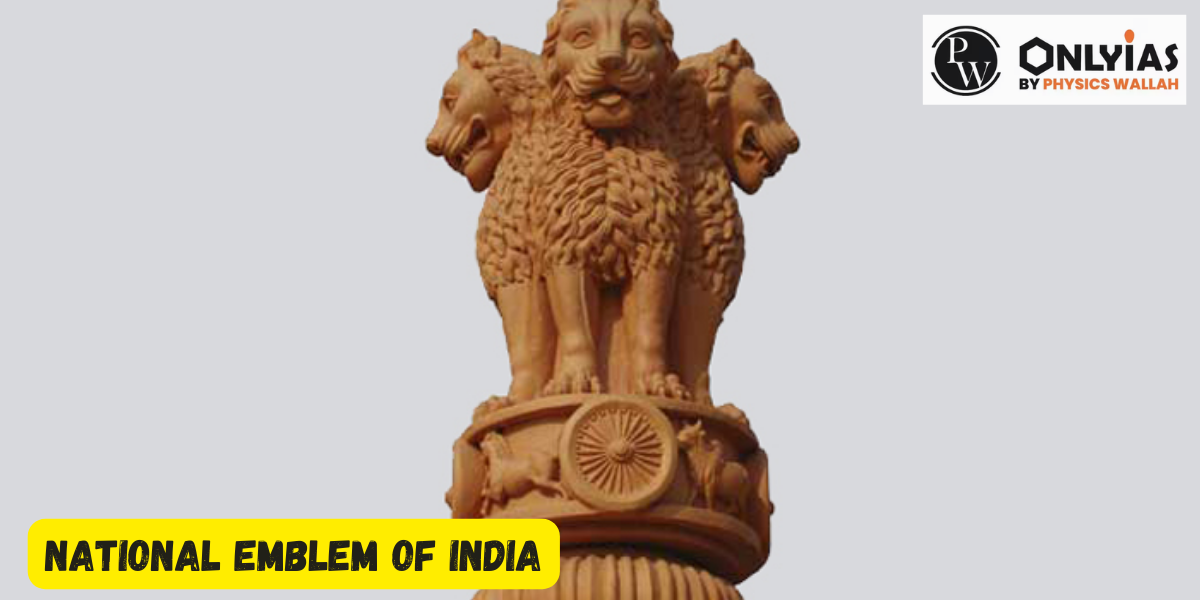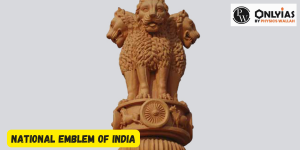
National Emblem of India: The State Emblem of India, derived from the Lion Capital of Ashoka Pillar located in Sarnath, Uttar Pradesh, serves as the representative seal of the Republic of India. It was formally adopted as the State Emblem on January 26, 1950. The motto “Satyamev Jayate,” signifying “Truth Alone Triumphs,” is an integral part of the emblem.
Functioning as a symbol of authority, the National Emblem holds a prominent place in all official communications of the government.
This article delves into the historical background of the National Emblem of India, the regulations associated with its use, and the significance of the symbols etched within it. This topic holds significance for various government exams, particularly in the Prelims section.

National Emblem of India: An emblem is described as a symbolic representation, often depicted as a heraldic device or a distinctive symbol, representing a nation, organization, or family. Within this context, a nation’s National Emblem holds a unique position as an official seal that commands the utmost respect and allegiance. Serving as a potent symbol of authority, it embodies the core tenets of a nation’s constitution. The Indian National Emblem, officially adopted on January 26, 1950, is a result of the efforts of Madhav Sawhney.
Guided by specific regulations, the utilization of the Indian National Emblem is governed by the provisions of the State Emblem of India (Prohibition of Improper Use) Act of 2005. Any unauthorized usage is deemed a violation of the law and is subject to legal consequences.
The origins of the National Emblem harken back to the 3rd Century BC, a period shaped by the visionary reign of Mauryan Emperor Ashoka. Rising from a tumultuous era marked by conflict, Ashoka embraced a path of non-violence and spiritual enlightenment, championing Buddhism and the pursuit of peace. In 250 BC, the Lion Capital was erected at Sarnath, the very site where Buddha imparted his profound wisdom on Dharma to his disciples. This iconic spot became a testament to Ashoka’s transformation and his commitment to fostering harmony.
The Ashoka Pillar stood not alone, as a series of similar columns adorned the empire. Over time, these pillars succumbed to the earth, their significance obscured. An ambitious endeavor to unearth these relics began in December 1904 under the leadership of Friedrich Oscar Oertel, a German-born civil engineer. In March 1905, after more than a year of excavation, the Ashoka Pillar of Sarnath emerged, revealing itself in three distinct segments.
The National Emblem, represented by the Ashoka Pillar of Sarnath, resonates deeply with the sentiments of every Indian. It embodies the nation’s rich history and evokes a sense of pride. Serving as an official signature of the Indian government, it carries the weight of authority. The emblem holds such importance that its misuse is subject to legal repercussions, underscoring the reverence demanded for this symbol.
Featuring three lions, the emblem symbolizes the values of peace, justice, and tolerance. It stands as a reminder of India’s enduring commitment to these ideals, echoing the legacy of Ashoka’s transformative journey and his quest for a harmonious society.

The National Emblem of India, a symbol of the nation’s sovereignty and unity, holds a significant place in the country’s identity. This iconic emblem, interchangeably known as the ‘State Emblem,’ is a representation of India’s historical and cultural heritage. Aspirants preparing for UPSC examinations will find it crucial to delve into the brief yet essential facts surrounding this emblem.
From its origin inspired by the Sarnath Lion Capital of Ashoka to the symbolism behind its elements, this article sheds light on key aspects of the National Emblem that are integral to various government exams, particularly in the Prelims section.
| Question | Answer |
|---|---|
| Animals in the national emblem of India | Four different animals: Asiatic Lion, Elephant, Bull, and Horse Numbers: Four Asiatic Lions and one each of Elephant, Horse, and a Bull |
| Name of the Indian national emblem | National Emblem of India (Interchangeably called the ‘State Emblem’) |
| Design of the national emblem | Sketched and illuminated by Dinanath Bhargava |
| National emblems in India | India has one National Emblem – The National Emblem of India |
| Significance of Ashoka Chakra | Symbolizes Buddhist Dharmachakra, represented with 24 spokes |
| Source of the national emblem adaptation | Sarnath Lion Capital of Ashoka, adopted on January 26, 1950, with the enactment of the Indian Constitution |
The State Emblem of India draws its inspiration from the Lion Capital of Ashoka situated in Sarnath. The original artifact features four lions, aligned in a back-to-back arrangement, positioned on a circular abacus that rests upon a bell-shaped lotus. Adorning the abacus are intricate high-relief sculptures portraying an elephant, a galloping horse, a bull, and a lion. These sculptures are interspersed with Dharma Chakras, representing the eternal cosmic order.
The State Emblem, as adopted on January 26, 1950, underwent a slight alteration from its precursor. The profile of the Lion Capital showcases three lions mounted on the abacus, encircling a central Dharma Chakra. To the right stands a bull, while a galloping horse graces the left. The extremities bear the outlines of Dharma Chakras. Notably, the bell-shaped lotus was excluded in this rendition.
Embedded beneath this profile, the State Emblem also carries the revered motto “Satyameva Jayate,” meaning ‘Truth Alone Triumphs,’ inscribed in the Devanagari script. This emblem stands as a powerful representation of India’s foundational values and aspirations.
The National Emblem of India, a representation etched into the nation’s collective identity, carries a wealth of historical, cultural, and symbolic significance. From its origins rooted in the Ashoka Pillar to its presence in official government documents and public spaces, this emblem encapsulates the essence of India’s values and aspirations.
Aspiring UPSC candidates seeking a comprehensive understanding of this emblem will find these 20 key points to be a compass guiding them through its intricate details and broader implications.
India’s National Emblem finds its roots in the iconic Lion Capital of Ashoka, an ancient artifact housed in the Sarnath Museum. These Ashoka Pillars, scattered across Northern India, were commissioned by Emperor Ashoka during the 3rd century BC. The original pillar at Sarnath showcases four majestic lions standing back to back, mounted on an abacus adorned with intricate reliefs depicting an elephant, a galloping horse, a bull, and a lion. These are interspersed with wheels and crowned by a bell-shaped lotus.
In the emblem adopted by the Government of India, three lions take the spotlight, while the fourth remains concealed, nestled in the background. A central wheel takes prominence on the abacus, flanked by a horse on the left and a bull on the right, accompanied by faint outlines of additional wheels. The distinctive bell-shaped lotus, however, is absent from this rendition.
This knowledge of the National Emblem’s origins and its linkage to the Ashoka Pillar is of paramount importance, particularly for UPSC aspirants. The UPSC frequently includes questions related to national symbols, anthems, languages, and emblems, all of which are vital facets covered within the India Yearbook.

At its base rests the Dharma Chakra, commonly recognized as the Wheel of Law, encircled by depictions of an elephant, a horse, a bull, and a lion. These figures are interspersed with intervening wheels, all atop a graceful, bell-shaped lotus. This intricate composition was officially anointed as the National Emblem of India by the Indian Government on January 26, 1950.
Incorporated at the heart of India's national flag is the Ashoka Chakra, a profound symbol. This intricate wheel symbolizes the essence that life thrives in motion while stagnation leads to decay.
The national emblem of India features the Lion Capital of Ashoka, which includes four lions mounted back to back on a circular abacus.
India takes pride in a diverse array of 17 national symbols, each encapsulating a unique facet of its identity. From the revered Tiranga, the tricolor flag, to the soul-stirring strains of Jana Gana Mana, the national anthem, and the stately representation of the National Emblem of India, these symbols embody the nation's spirit, culture, and natural heritage. The list also includes the regal Royal Bengal Tiger, the iconic Indian Peacock, the sacred Ganges River, the symbolic Indian Banyan tree, and more. These symbols serve as a powerful reminder of India's rich tapestry of traditions, natural wonders, and collective values.
<div class="new-fform">
</div>
